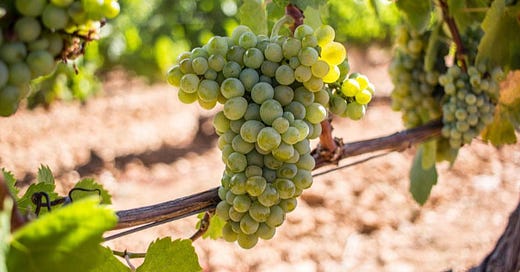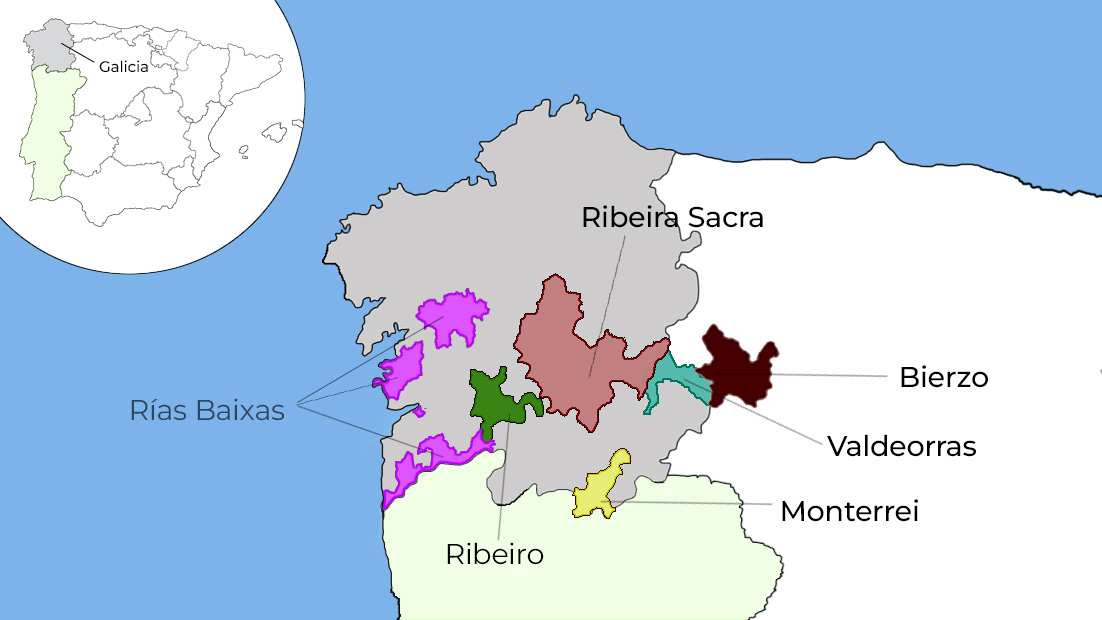Godello - a Spanish survivor
In which we look at an increasingly popular Spanish wine grape that nearly went extinct.
Godello grapes hanging on the vine at the Casar de Burbia vineyard © Casar de Burbia - all rights reserved
For a long time in Spain, if you popped into your local bar and ordered a glass of white wine you would have usually have been given the local brew from wherever you happened to be or a glass of verdejo if you didn’t happen to be in a wine -producing area.
These days, as with everything, the choices are becoming more varied. And whilst the best bars will always offer you something local when it’s worth promoting, the standard options you’ll get are Verdejo, Albariño or Godello.
Verdejo is the workhorse grape of Spanish white wine grapes, and something that most white wine drinkers here will sample on a regular basis, even if they aren’t aware of it. And Albariño is a Galician grape that is getting increasingly noticed both here and abroad for its delicious mix of fruit flavours and crisp acidity (more about that in another post.)
But what about Godello? For many - even here in Spain - it’s a relatively unknown grape. But it’s well worth exploring if you get the chance. So let’s delve in and find out more about it.
For a start, we’re lucky to have Godello with us because it nearly went extinct. Firstly, it was hit by phylloxera. Phylloxera is an insect that plagued European vineyards in the 19th century and had a massive impact on the Spanish wine landscape. And whilst you can still find vines that date back to pre-phylloxera days, a lot of Galicia’s vineyards were impacted by the plague.
On top of that, the grape itself isn’t that easy to work with. It can be difficult to cultivate and often delivers low yields. Combine that with a series of export limitations that Franco introduced – not just on wine, but on a range of Spanish products – and many winemakers just felt Godello wasn’t worth the effort.
Fortunately, we didn’t lose Godello forever. And for that we can thank Horacio Fernández Presa.
In the 1970s, he launched a project called REVIVAL which focused on restructuring vineyards in Valdeorras - one of the 5 Denominaciones de Origen in Galicia - and reviving native grapes in the region – most notably Godello.
Thanks to Horacio’s work we are still enjoying Godello today. And the winemakers of Valdeorras continue to pay homage to the man they call the father of Godello.
As we’ve seen, Godello is primarily produced in Valdeorras as well as in Monterrei, another Galician DO. But you’ll also find it being used across the border in the Bierzo region of Castilla y León. These regions, especially Galicia, offer cool wet climates, mountainous landscape, and granite and slate soils, which provide perfect conditions for the Godello grape really help to give it the minerality that characterizes these wines.
Godello can take quite a bit of work to get the best out of it. It’s an early-ripening grape that delivers quite low yields. This means it certainly doesn’t work for mass-produced wines.
That has its pros and cons. On the one hand, it means you’re almost always going to get a well-crafted wine with Godello. But it also means you may have to pay a touch more for it.
The wines you get from Godello tend to be straw-coloured with good acidity, plenty of body and slightly higher levels of alcohol than other whites.
You can expect strong fruit flavours – a mixture of citrus and green apple together with sweeter fruits like peach. But you’ll also get a touch of salt and that mineral flavour we mentioned before. You really can sense the slate coming through in the taste of this wine. That makes it more complex and structured than normal whites.
Usually, Godello is fermented in stainless steel vats to avoid messing with that fruit and mineral combination. But it does sometimes get aged in wooden barrels, which can give it a slightly nutty or toasted flavour and can make it quite similar to a Chardonnay.
Because of that combination of flavours, Godello wines go really well with shellfish, but the fact that they have more body and more complex characteristics means they also work with stronger flavours like octopus with paprika or anchovies and it’s a great accompaniment to cheeses.
If you’re looking to try a Godello wine, why not start with the entry-level Godello from Casar de Burbia. It’s an elegant wine with floral, spice and green fruit aromas against a more mineral and citrus background. Its eight months on lees helps provide structure, with lots of volume and unctuosity. Nicely balanced acidity, with a pleasing citrus and mineral aftertaste.
Or if you want a more gastronomic option, try their Valdepiñeiro. With a long maceration, partial fermentation in French oak barrels, and extended contact with the lees, this is a wine packed with character and complexity where aromas of peach and mango, mingle with flowers and citrus fruits against a mineral background to give a wine that’s smooth, silky and fleshy on the palate. Delicious!
If you haven’t tasted Godello before we really recommend you pick up a bottle and give it a try. And if you’re not sure where to start then simply pick one of the wines above and start enjoying.
Cheers!






Aldi have got a very nice Godello coming out in May.£9.99 is a lot for Aldi wines,but this example is worth it.
Hi Matthew! I discovered Godello wine on a trip to Vigo last year and absolutely fell in love! I have to say, this piece about its history has given me a newfound appreciation, especially since the grape neared extinction and experienced a renaissance only in recent decades. Thanks for sharing its fascinating backstory (I even reference it in my recent Vigo travel guide). Cheers! 🥂